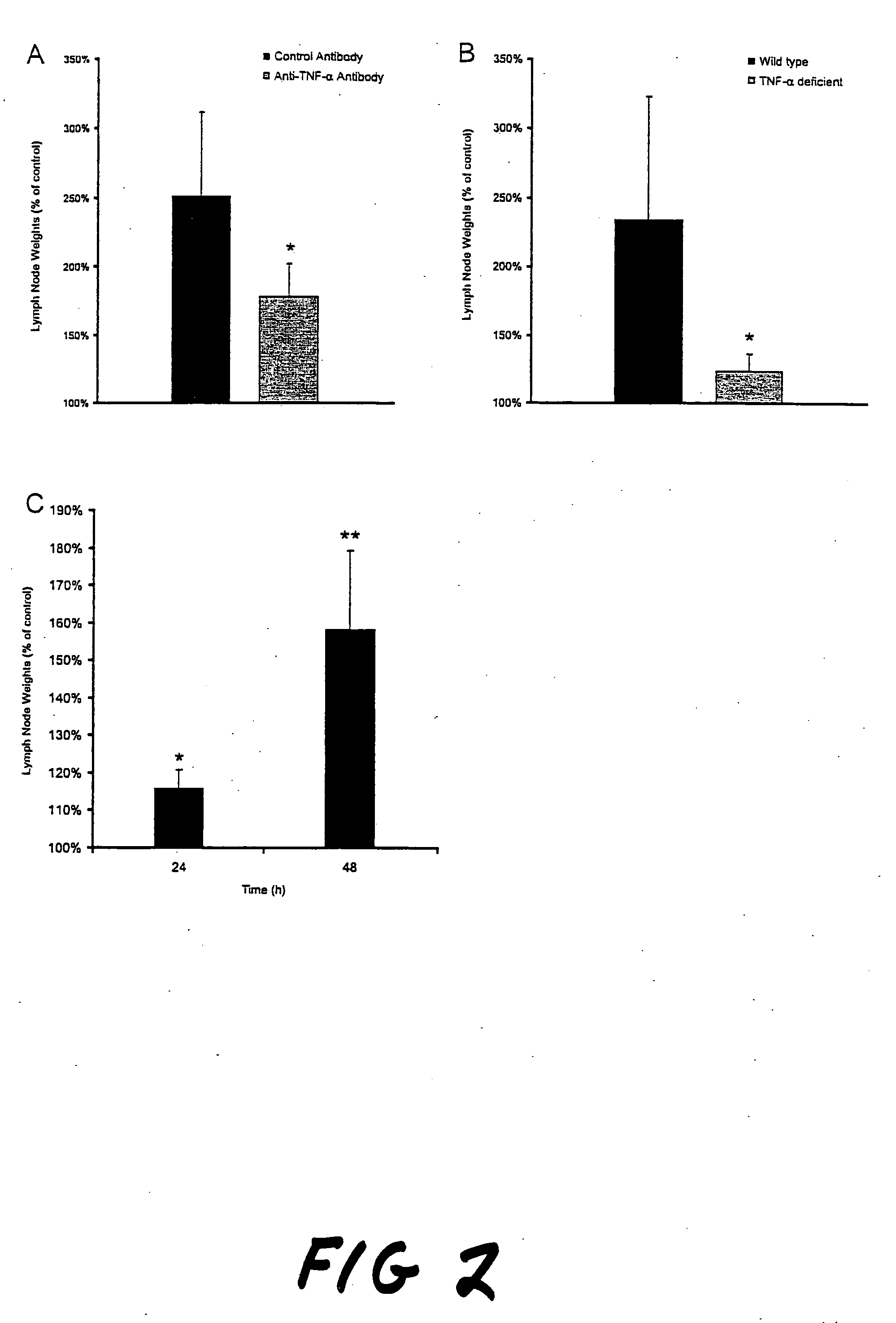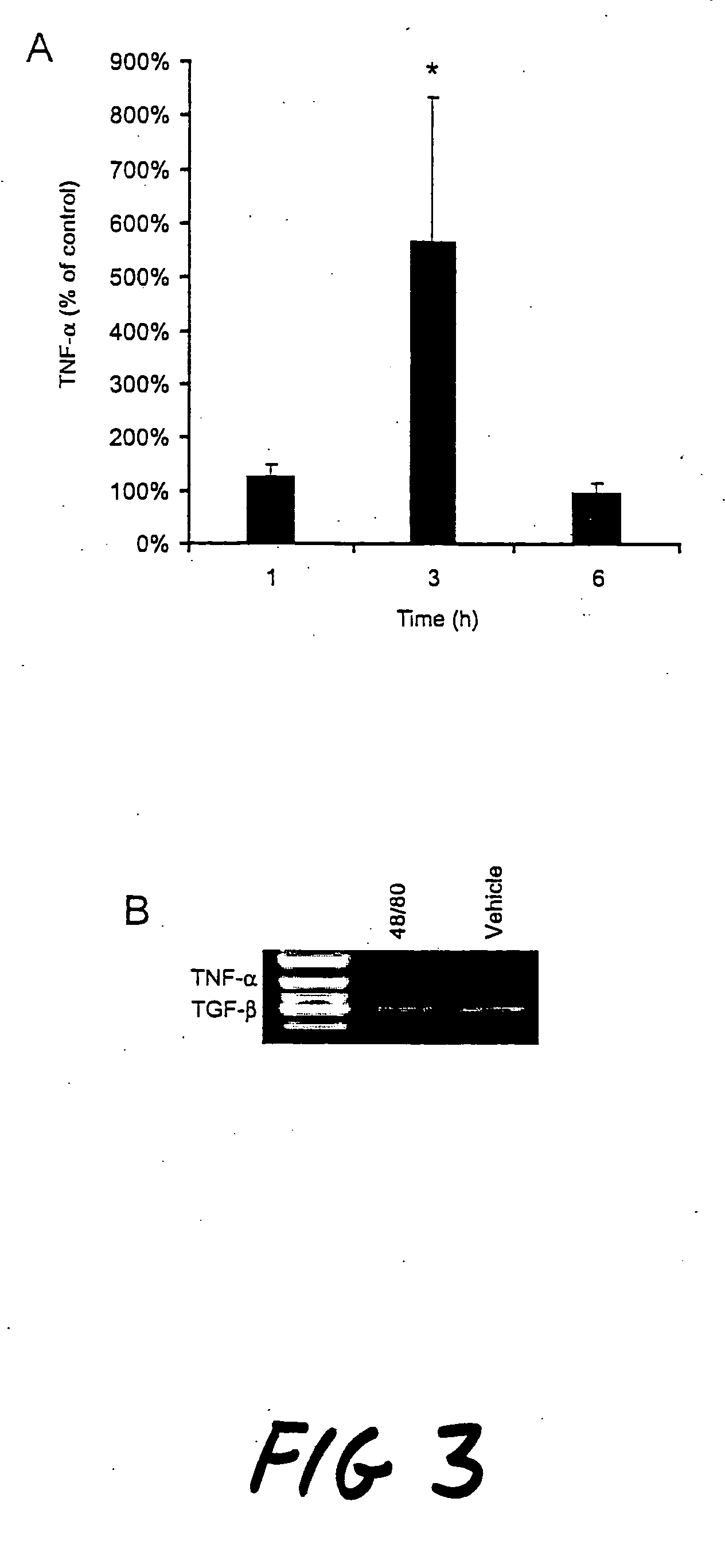Novel adjuvant capable of specifically activating the adaptive immune response
- Summary
- Abstract
- Description
- Claims
- Application Information
AI Technical Summary
Benefits of technology
Problems solved by technology
Method used
Image
Examples
example 2
FIG. 5 shows antigen-specific antibody serum (IgG) and mucosal (IgA) responses using compound 48 / 80 as an nasal vaccine adjuvant.
FIG. 5A, (C57BL / 6×BALB / c)F1 female mice were nasally immunized with recombinant Bacillus anthracis protective antigen (rPA) alone or in the presence of cholera toxin (CT) or four-fold serial dilutions of compound 48 / 80 (48 / 80). Immunizations were instituted on days 0, 7, and 14. On day 21-22 (FIG. 5A), serum was collected and tested for the presence of anti-PA IgG. Both CT and 48 / 80 provided significant adjuvant activity at all doses tested as indicated by the anti-PA IgG geometric mean titers indicated (p<0.05). Compound 48 / 80 used at 125, 31 and 8 μg was as effective as CT when used as a nasal vaccine adjuvant based on antigen-specific IgG serum titers (p<0.05)
FIG. 5B-D shows antigen-specific vaginal, salivary and fecal IgA responses in (C57BL / 6×BALB / c)F1 female mice nasally immunized with recombinant Bacillus ant...
example 3
Adjuvant Activity
Female (C57BL / 6×BALB / c)F1 mice were nasally immunized with 10 μg recombinant protective antigen (rPA) alone or in the presence of 1 μg cholera toxin (CT) or 8 μg compound 48 / 80 (48 / 80) on days 0, 7, and 140 n day 175, serum was collected and tested for the presence of anti-PA IgG by ELISA. As shown in FIG. 6, both CT and 48 / 80 showed a significant adjuvant activity over PA alone (p=0.001 and 0.002 respectively). This demonstrates the long lasting nature of 48 / 80 as an effective adjuvant.
example 4
Induction of Protective Antibody Responses
Female (C57BL / 6×BALB / c)F1 mice were nasally immunized with recombinant Bacillus anthracis protective antigen (rPA) alone or in the presence of cholera toxin (CT) or in the presence of 125 μg compound 48 / 80 (48 / 80). Day 22 serum was tested for the presence of antibodies that could neutralize the toxicity of anthrax lethal toxin using a macrophage anthrax toxin toxicity assay. In this assay, lethal toxin kills macrophages (low optical density) and in the presense of protective anti-PA antibodies, the macrophages survive (high optical density). Sera (diluted 1:8) from naïve mice, mice immunized with PA alone, or mice immunized with PA plus CT failed to prevent lethal toxin induced death in macrophages (FIG. 7). In contrast, serum from mice immunized with PA plus 48 / 80 provided complete protection from antrax lethal toxin induced cell death (FIG. 7) These results suggest that while antigen specific IgG antibody endpoint titers are comparable w...
PUM
| Property | Measurement | Unit |
|---|---|---|
| Immunogenicity | aaaaa | aaaaa |
Abstract
Description
Claims
Application Information
 Login to View More
Login to View More - R&D
- Intellectual Property
- Life Sciences
- Materials
- Tech Scout
- Unparalleled Data Quality
- Higher Quality Content
- 60% Fewer Hallucinations
Browse by: Latest US Patents, China's latest patents, Technical Efficacy Thesaurus, Application Domain, Technology Topic, Popular Technical Reports.
© 2025 PatSnap. All rights reserved.Legal|Privacy policy|Modern Slavery Act Transparency Statement|Sitemap|About US| Contact US: help@patsnap.com



